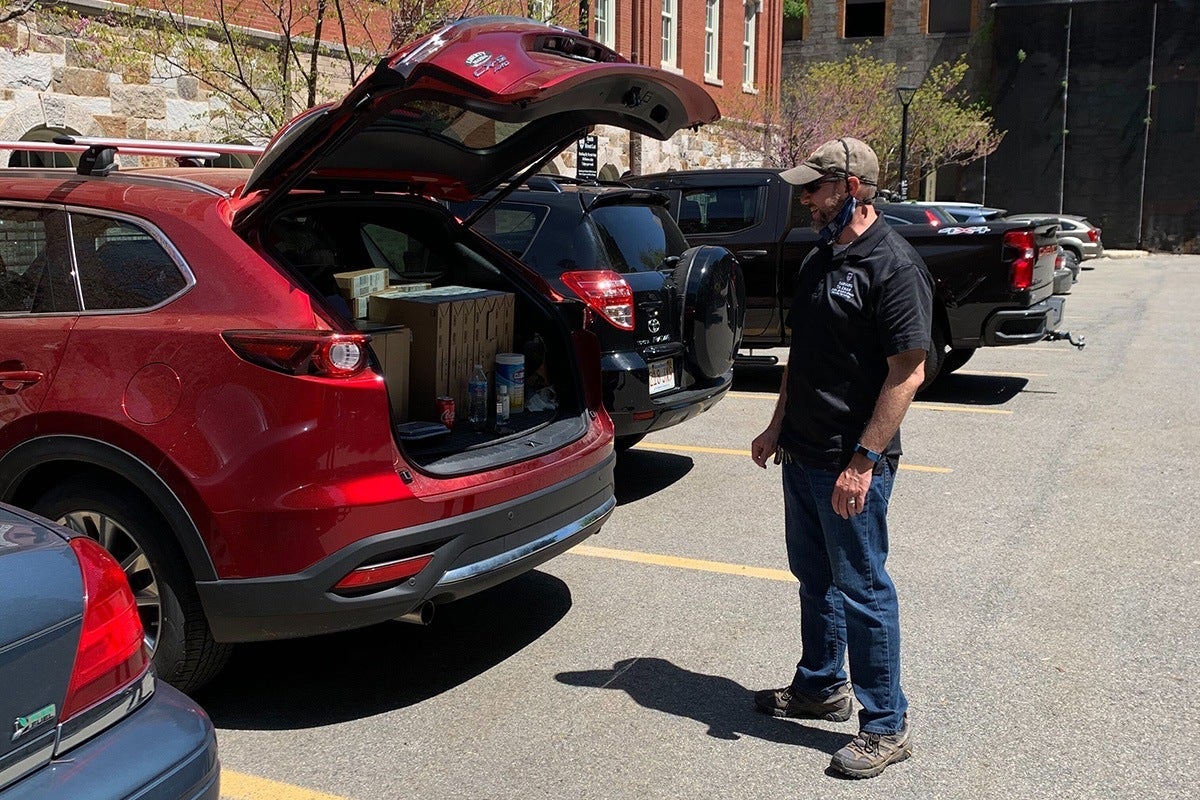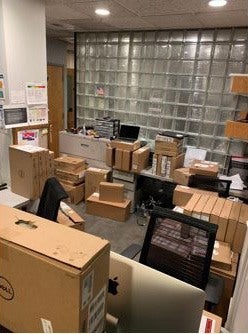Amid pandemic, School’s IT team keeps everyone connected

Transitioning Harvard Chan School to online working, teaching, and learning during the COVID-19 pandemic required a swift pivot for the information technology team
August 11, 2020 – To say that the Department of Information Technology (IT) team at Harvard T.H. Chan School of Public Health—those who handle everything from upgrading computers to checking mics at lectures to producing online courses—have had their hands full over the past few months is something of an understatement.
A sampling: Back in March, when the School shifted to remote work and learning, the team got faculty, staff, and students up and running with Zoom in just two weeks’ time. They handed out computer hardware from a parking lot. They created a series of “remote readiness” web pages. They strengthened security when unwanted guests “Zoom bombed” events and meetings. They helped whip up a totally online commencement.
While keeping the School connected during the pandemic has posed many challenges for the IT team, they also say that the pandemic has been an unlikely catalyst for improvements on a number of fronts. IT staff have stepped up efforts to help faculty and teaching staff learn how to run an online class. The IT website is chock-full of new information on teaching, learning, and working remotely. And technicians are taking advantage of empty classrooms and conference rooms to upgrade worn-out technology.
Classes go virtual
Getting all spring courses online was top priority when the campus closed in mid-March. Luckily, the School had recently finished transitioning from the Blue Jeans to Zoom platform for online courses and meetings, so everyone at the School already had access.
IT collaborated primarily with colleagues in the Office of Education and with department and academic administrators to help shift roughly 180 courses online. Before the pandemic, IT had held roughly five Zoom trainings per month. After the School transitioned to remote learning, the team made a rapid-fire switch to holding trainings daily.
“Typically, to produce online courses, we start working nine months in advance,” said Sejal Vashi, manager of digital learning. “So what we offered was just enough to get faculty started and to know there’s a team here to help if they have questions.”
The transition went smoothly for the most part, although there were some challenges among faculty who had never used Zoom. They had to learn some of the platform’s intricacies, such as how to use a whiteboard, how to hold an online discussion, and how to show a video or film during class.
Faculty members continued to hold live classes at their regular times and were encouraged to record their classes for international students in different time zones. Vashi said her team continues to work on how to make the remote learning experience better for students, particularly for those in challenging environments. “A big ongoing issue is if someone doesn’t have a good internet connection or good equipment, or a space where they can concentrate,” she said.
On the plus side, conducting classes via Zoom has led faculty members “to take a deeper look at their courses in ways they didn’t have to before,” Vashi said. “I think a lot of them are taking the opportunity to think about asynchronous materials they can create right now. For example, they might produce a video of a guest speaker who can’t visit campus. Or they might create a video that teaches a tricky concept, so that students can rewind and pause.”
Technology from a car trunk
The field services team, in addition to handling help desk calls, has focused on making sure that staff and faculty get the equipment they need from their offices, as well as providing new equipment if necessary.
With buildings closed, Noah Hulbert, manager of IT field support services, got creative. Masked and gloved, he set up shop one day every other week in the parking lot at 90 Smith Street beginning in early April, using the trunk of his car as a repository for computers, monitors, and printers. He met people at designated times for handoffs.
“Noah did every appointment by himself until sometime in mid-May,” said Kate Targett, director for customer engagement and technology services. “He’s definitely been wearing a cape with his mask.”
There were some snafus. In one instance, IT ordered 12 Dell computers that accidentally got shipped to the wrong address—to the home of an employee in Chelsea, who dutifully lugged them to his apartment for safekeeping until Hulbert could retrieve them.
Mayrelis Sanchez, user support assistant, recalled hauling equipment from the Landmark Center without a cart. “We’d do two or three trips depending on what people needed,” she said. “It was definitely a challenge—literally a heavy lift.” To gather equipment from Kresge, she’d park in the fire lane on Huntington Avenue and hurry in through the FXB building entrance (the Kresge entrance was closed). “Thank God I never got a ticket,” she said.

Things got somewhat easier for the field services team after a few weeks. They eventually got a cart at Landmark, for one thing. And the IT team returned to its home base in the Kresge building in June. Now, for four days each week, the office is manned by one staff member at a time who meets clients by appointment only. After weeks working outside, toggling between campus buildings, her car, and the 90 Smith Street parking lot, Sanchez said being back in Kresge was a relief. “Working indoors, at least you have air conditioning,” she said.
Fine tuning
Video producers at the School have worked to ensure that classes, webinars, lectures, and events, whether recorded or live, look as good as possible on Zoom.
“When we went remote, we very quickly realized we didn’t have the use of our studios anymore,” said Shawn DeAntonio, manager of media services and video production. “We had a calendar full of people we needed to record for online courses with no studio to record them in. But the video producers worked quickly to figure out the best way to use Zoom for those recordings.” That meant testing and tweaking to figure out the best technical settings and coaching people in their homes to ensure the best lighting, sound quality, and background.
DeAntonio is particularly proud of the work his team did on the School’s online graduation video. “In just about six weeks we helped create a graduation online that had the look and feel of actually being there live, even though it was pre-recorded,” he said. “We wanted it to be as good as possible for our graduates’ special day.”
The technicians on DeAntonio’s team—those who are typically on hand in classrooms and at events managing audio and video—have now pivoted to getting the campus tech-ready for when it eventually reopens. “We have a lot of classrooms and conference rooms with failing functions, and we keep trying to fix them, but we can only duct tape them because the rooms are in constant use,” DeAntonio said. “We now have this huge window of time where we can replace everything.”
The IT staff is also planning for the possibility that some classes might be taught both in-person and online. “It’s a huge challenge,” said Deane Eastwood, chief information officer. “Most of our spaces are not ready to show both the teacher and students online. We’re going to have to put a lot of thought into it.”
‘Over-the-moon appreciative’
For the IT team, people’s appreciation for their work has been a big plus. “IT isn’t visible unless it’s broken,” said Targett. “But how much we depend on it is more clear than ever before.”
Hulbert said that even though working out of a parking lot wasn’t ideal, it was actually fun. “That’s because the vast majority of people were just over-the-moon appreciative that we were going out of our way to get their mouse or keyboard or monitors,” he said. “We work for a really nice community.”
photos courtesy Kate Targett


